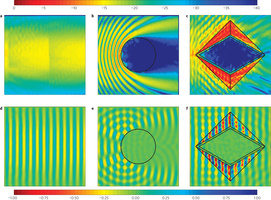This article is more than 1 year old
'Perfect' INVISIBLE SHED stuns boffinry world
Not a cloak. Not strictly invisible either, at that
Invisibility cloaks - or, more correctly, sheds - inched a little closer to reality this week with the revelation that scientists have made an object flawlessly invisible.
Previous attempts to make objects invisible had succeeded in bending light around their edges, but left a dark shadow behind the object because of some light reflecting off it. This time, there was no reflection, no shadow and the object was perfectly invisible.
Unfortunately the object was a static 1cm tall cylinder, it was only invisible to microwaves (not visible light) and the invisibility effect only worked from one angle. Boffins have not yet succeeded in making invisibility cloaks for large moving objects in visible light. As and when they do, we have on the authority of top invisibility boffin John Pendry that the result will not be anything cloak-like.
"This isn't anything that flaps around in the breeze; it's more like a shed," he commented in 2006.

Cloaking a copper cylinder from microwaves with a diamond shaped shield, Nathan Landy, published Nature Journal
However the boffins' work now published marks a big advance in the field of transformation optics and is a milestone in a huge area of research that could transform computers.
According to the BBC, the trick was to use a diamond-shaped cloak, with properties carefully matched at the diamond's corners, to shuttle light perfectly around a cylinder 7.5cm in diameter and 1cm tall.
It only worked from one direction.
"It's like the card people in Alice in Wonderland," lead researcher Professor David Smith from Duke University, told the BBC. "If they turn on their sides you can't see them but they're obviously visible if you look from the other direction."
Scientists told the BBC it would be very hard to implement the same effect with visible light.
Either the object has to be really tiny or else the type of radiation being used has to be long - with say microwaves 1mm-1m, or radio waves 1mm to 100km. Optical lightwaves are just a few hundred billionths of a metre.
While invisibility cloaks seem far off, the uses in other fields are manifold: from heat-cloaking processors in computers, to using optics as an alternative to electronics in computers to multiple military and telecoms uses including cloaking ships from detection and ramping up the speed of the internet.
As Professor Smith and grad researcher David Landy write in their abstract:
In 2006, invisibility became a practical matter for the scientific community as well, with the suggestion that artificially structured metamaterials could enable a new electromagnetic design paradigm, now termed transformation optics.
®
Research paper 'A full-parameter unidirectional metamaterial cloak for microwaves'by Nathan Landy and David R Smith was published in Nature on 11th November 2012
